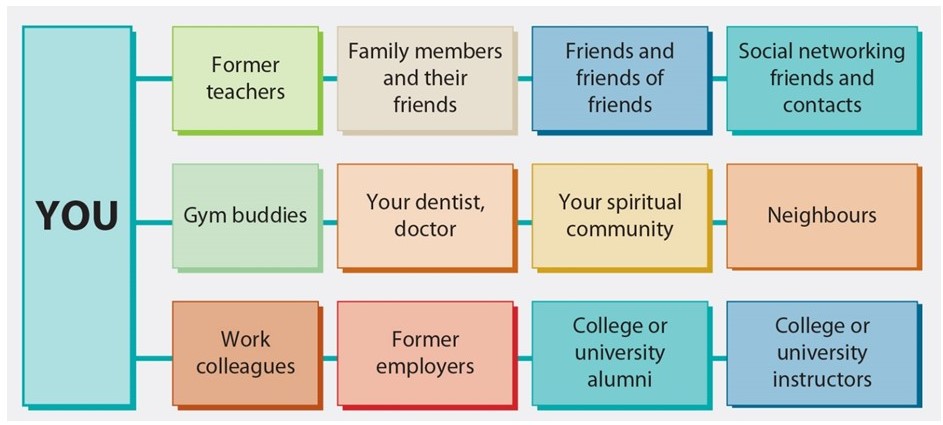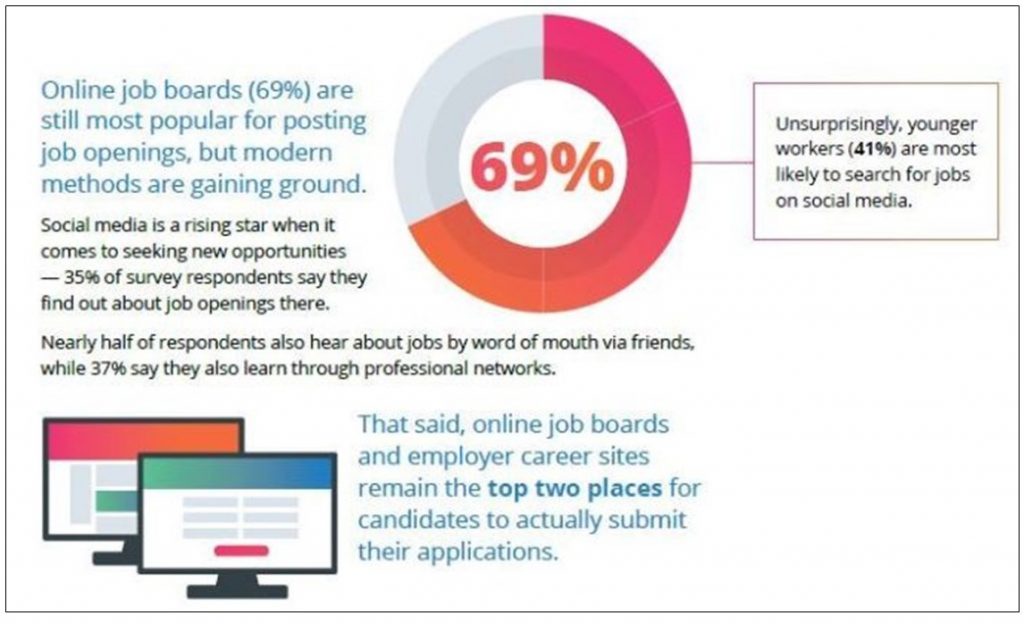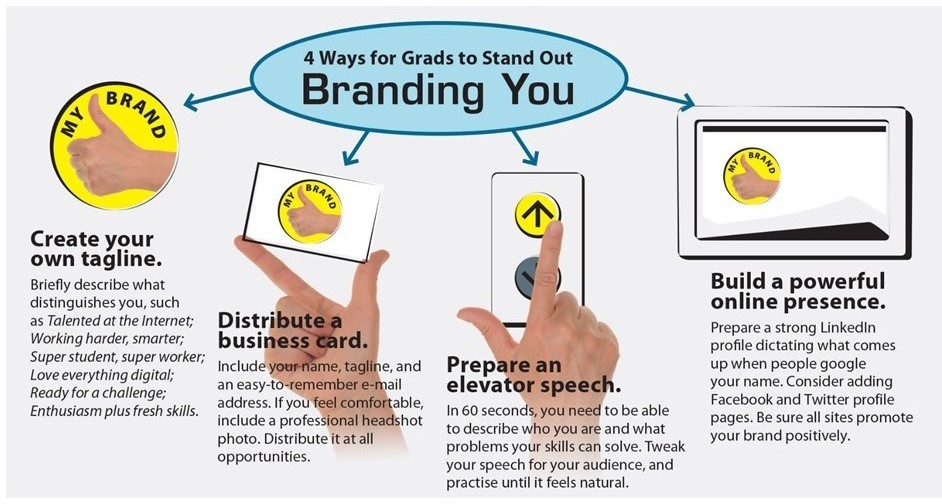Unit 47: The Job Search Process
Learning Objectives
 After reviewing this information, you will be able to
After reviewing this information, you will be able to
-
-
- identify and assess individual skills, strengths, and experiences to identify career and professional development goals
- understand effective job search strategies for today’s job market
-
Introduction
If you devote a portion of your life to training for a career, nothing is more important at the end of that program than getting a job where you can apply your training. The job application process poses a challenge that requires a skillset quite different from that which your core program courses teach you, yet you cannot get a job without this skill set. In most professions, the competition for jobs is so fierce that only your communication A-game can help you through the communication test that is the hiring process.
The following video provides an overview of what you will need to do to find your dream job.
Job Search Strategies
Finding a job in this very competitive job market may require the use of traditional and non-traditional strategies. Some of these strategies are examined here.
Networking
A recent study showed that approximately 61% of job seekers either used their personal network and/or online social network to land their dream job (Business Communications, 2019). What exactly is a personal network and why is it so effective? A network is a group of people with whom you have a personal relationship based on similar interests. As you build this network and cultivate the relationships, you develop a connection and most importantly trust with your the people in your network. These relationships come in very handy because the majority of the job market is hidden, that is, jobs that are not advertised through conventional avenues. Most jobs are often found through referrals and word of mouth; thus, having a network of people that can give you inside information about available jobs in your field is invaluable. In addition to the inside information, people in your network also serve as personal references and a bridge between your potential employer and you. Some tips to help you develop a personal network include:
- Develop a list of people to speak with about your job search
- Contact the people on your list
- Call and possibly arrange a meeting with any referrals provided by your contact list
- Join an online networking group
- Conduct research on additional networking tips and trends

Online Job Sites
According to a recent Jobvite survey, job boards continue to be the number one medium to access job opportunities (Morgan, 2019). Major job search engines like Monster and Indeed are good places to start your job search process. However, both job seekers and employers have their objections to these sites. To job seekers, applying for a job through a job board can be frustrating for the following reasons:
- Some will strip out the formatting you’ve meticulously assembled for your résumé and cover letter
- Submitting confidential information about yourself to them feels risky
- They can feel like vast abysses into which you send dozens of applications you’ve laboured over for hours, but without ever receiving a response back
To employers and recruiters, the big job sites attract a flood of poor-quality applicants from around the world, leaving the hiring manager or committee with the time-intensive job of sorting out the applicants worth seriously considering from the droves of under-qualified applicants taking shots in the dark with what amounts to spam applications. With such a demanding selection process, employers simply don’t have time to respond to every applicant.
Nonetheless, ignoring these sites altogether would be a mistake because too many employers use them to advertise positions. When your full-time job is just to find a full-time job, you can’t leave any stone unturned. The following are sites worth searching for job postings and other information they offer on the job market:

- Job Bank
- Monster
- Indeed
- Workopolis
- CareerBuilder
- Eluta
- Jobboom
- Glassdoor
- SimplyHired
- WOWjobs
- Charity Village
Industry Conferences and Job Fairs
Attend industry conferences and network with participants. Joining a professional association and attending its meetings and conferences will give you ample opportunities to network with employers and their recruiting agents. As in the previous scenarios, this only works if you are friendly and outgoing. Conference participants who merely soak in others’ presentations and discussions without networking are effectively invisible to the recruiters. You should also attend career fairs and sign up for interviews with visiting recruiters. Because colleges are a greenhouse for the emerging labour pool, they have tight connections with industry partners . When company recruiters come to your college, be there to ask them about their employment opportunities. Recruiters aren’t interested in students who aren’t interested in them. Attending career fairs and talking to recruiters is a great way of showing interest.
Personal Branding
What is a personal brand and how do you develop one? The following TEDx talk provides an excellent explanation of the topic.
Begin developing your personal brand by asking yourself the following questions:
- what about yourself do you want to emphasize in the job search process?
- What qualities distinguish you from everyone else?
- What unique skills can you offer your employer?
- What makes you a sought after employee?
- How will you make your future workplace better?
Use this information to promote yourself in online and offline forums. Online, create a Facebook page and a LinkedIn profile. Offline, create business cards and write a elevator pitch to introduce yourself at industry conferences and job fairs. No one will do better job at promoting you, than you will.


- Begin developing your network. Conduct at least one referral interview or join one online networking group. Record the results you experienced and the information you learned from the networking options you chose.
- Use several of the job search engines listed in above to collect about half a dozen job postings that you would be interested in applying to if they were available upon graduation. If you can’t find any in your local region, look further afield in neighbouring cities or even other provinces or countries you’d be interested in moving to. Compare the various postings. Identify common terms used in the lists of required skills and job duties. What are the common work experience and educational qualifications identified as required as assets?
References
BI Norwegian Business School. (2017). The job hunting process [Video]. Youtube. https://www.youtube.com/watch?v=WRC7y8VriuM
Guffey, M., Loewry, D., & Griffin, E. (2019). Business communication: Process and product (6th ed.). Toronto, ON: Nelson Education. Retrieved from http://www.cengage.com/cgi-wadsworth/course_products_wp.pl?fid=M20b&product_isbn_issn=9780176531393&template=NELSON
Morgan, H. (2019). A candidate’s job market means stronger competition for job seekers. The savvy intern. Retrieved from https://www.youtern.com/thesavvyintern/index.php/2019/05/20/stronger-competition-job-seekers/
TEDx Talks. (2017). Designing a personal brand from zero to infinity [Video]. Youtube. https://www.youtube.com/watch?v=Alqt7pIbp_o
Held for people working in the same company or industry to discuss new trends and opportunities pertaining to the business
A recruiting event in which employers and recruiters meet with potential employees and where job seekers gain information about job openings at potential employers.

